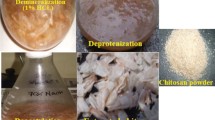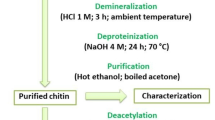Abstract
The aim of this study was to evaluate the antibacterial properties of oyster, hard clam, and sea urchin shell powders as a result of calcination. After subjection to calcination at 1050 °C for 2 h, and as identified by FTIR and XRD spectra, the structures of oyster, hard clam, and sea urchin shell powders were mainly transformed into calcium oxide, with slight amounts of calcium hydroxide. Metal content testing revealed no detectable harmful heavy metals, and showed rich content of trace elements including Ba, Sr, Mg, and Mn. To evaluate their antibacterial properties, activity against five foodborne microorganisms was assessed using the disk diffusion method, which indicated the presence of antibacterial activity in these products at a concentration of 1 %. These results indicate antibacterial potential for oyster, hard clam, and sea urchin shell powders after subjection to calcination.




Similar content being viewed by others
References
Harnedy PA, FitzGerald RJ (2012) Bioactive peptides from marine processing waste and shellfish: a review. J Funct Foods 4:6–24
Bulgariu D, Bulgariu L (2012) Equilibrium and kinetics studies of heavy metal ions biosorption on green algae waste biomass. Bioresour Technol 103:489–493
Park S, Li Y (2012) Evaluation of methane production and macronutrient degradation in the anaerobic co-digestion of algae biomass residue and lipid waste. Bioresour Technol 111:42–48
Gopi S, Subramanian VK (2013) Anomalous transformation of calcite to vaterite: significance of HEDTA on crystallization behavior and polymorphism at elevated temperatures. Indian J Chem B 52:342–349
Ngo DH, Wijesekara I, Vo TS, Ta QV, Kim SK (2011) Marine food-derived functional ingredients as potential antioxidants in the food industry: an overview. Food Res Int 44:523–529
Dickson JAD (2001) Transformation of echinoid Mg calcite skeletons by heating. Geochim Cosmochim Acta 65:443–454
Liu YC, Torita A, Hasegawa Y (2006) Scallop shell extract promotes recovery from UV-B-induced damage in rat skin epidermal layer. Fish Sci 72:388–392
Amarowicz R, Synowiecki J, Shahidi F (2012) Chemical composition of shells from red (Strongylocentrotus franciscanus) and green (Strongylocentrotus droebachiensis) sea urchin. Food Chem 133:822–826
Chen YC, Hwang DF (2014) Evaluation of antioxidant properties and biofunctions of polar, nonpolar, and water-soluble fractions extracted from gonad and body wall of the sea urchin Tripneustes gratilla. Fish Sci 80:1311–1321
Asada T, Omichi M, Kimura T, Oikawa K (2001) Bactericidal effect of calcium oxide and calcined shell calcium on Legionella pneumophila. J Health Sci 47:414–418
Yang Y, Yao Q, Pu X, Hou Z, Zhang Q (2011) Biphasic calcium phosphate macroporous scaffolds derived from oyster shells for bone tissue engineering. Chem Eng J 173:837–845
Bramhe S, Kim TN, Balakrishnan A, Chu MC (2014) Conversion from biowaste Venerupis clam shells to hydroxyapatite nanowire. Mater Lett 135:195–198
Çağri-Mehemtoğlu A (2011) Inhibition of Listeria monocytogenes and Salmonella enteritidis on chicken wings using scallop-shell powder. Poult Sci 90:2600–2605
Vecchio KS, Zhang X, Massie JB, Wang M, Kim CW (2007) Conversion of sea urchin spines to Mg-substituted tricalcium phosphate for bone implants. Acta Biomater 3:785–793
Salem MZM, Ali HM, Shanhorey NAE, Megeed AA (2013) Evaluation of extracts and essential oil from Callistemon viminalis leaves: antibacterial and antioxidant activities, total phenolic and flavonoid contents. Asian Pac J Trop Med 6:785–791
Bae DH, Yeon JH, Park SY, Lee DH, Ha SD (2006) Bactericidal effects of CaO (scallop-shell powder) on foodborne pathogenic bacteria. Arch Pharm Res 29:298–301
Balmain J, Hannoyer B, Lopez E (1999) Fourier transform infrared spectroscopy (FTIR) and X-ray diffraction analyses of mineral and organic matrix during heating of mother of pearl (Nacre) from the shell of the mollusk Pinctada maxima. J Biomed Nater Res 48:749–754
Lee SW, Jang YN, Kim JC (2011) Characteristics of the aragonitic layer in adult oyster shells, Crassostrea gigas: structural study of myostracum including the adductor muscle scar. Evid Based Complement Altern Med 2011:742963-1–742963-10. doi: 10.1155/2011/742963
Garcia JLT, Alvarez M, Aguilar DH, Quintana PJ (2008) Spectroscopic, structural and textural properties of CaO and CaO–SiO2 materials synthesized by sol–gel with different acid catalysts. J Non-Cryst Solids 354:729–732
Torita A, Miyamoto A, Hasegawa Y (2007) The effects of scallop shell extract on collagen synthesis. Fish Sci 73:1388–1394
Damien E, Revell PA (2004) Coralline hydroxyapatite bond graft substitute: a review of experimental studies and biomedical applications. J Appl Biomater Biomech 2:65–73
Li M, Yao ZT, Chen T, Lou ZH, Xia M (2014) The antibacterial activity and mechanism of mussel shell waste derived material. Powder Technol 264:577–582
Sawai J, Kawada E, Kanou F, Igarashi H, Hashimoto A, Kokugan T, Shimizu M (1996) Detection of active oxygen generated from ceramic powders having antibacterial activity. J Chem Eng Jpn 30:1034–1039
Sawai J, Shiga H, Kojima H (2001) Kinetic analysis of the bactericidal action of heated scallop-shell powder. Int J Food Microbiol 71:211–218
Choi YM, Whang JH, Kim JM, Suh HJ (2005) The effect of oyster shell powder on the extension of the shelf-life of kimchi. Food Control 17:695–699
Kim YS, Choi YM, Noh DO, Cho SY, Suh HJ (2006) The effect of oyster shell powder on the extension of the shelf life of tofu. Food Chem 103:155–160
Bodur T, Yaldirak G, Kola O, Çağri-Mehemtoğlu A (2010) Inhibition of Listeria monocytogenes and Escherchia coli O157:H7 on frankfurters using scallop-shell powder. J Food Saf 30:740–752
Bystrom A, Claesson R, Sundqvist G (1985) The antibacterial effect of camphorated paramonochlorophenol, camphorated phenol and calcium hydroxide in treatment of infected root canals. Endod Dent Traumatol 1:170–175
Siqueira JF Jr, Lopes HP (1999) Mechanisms of antimicrobial activity of calcium hydroxide: a critical review. Int Endod J 32:361–369
Mohammadi Z, Shalavi S, Yazdizadeh M (2012) Antimicrobial activity of calcium hydroxide in endodontics: a review. Chonnam Med J 48:133–140
Acknowledgments
This study was supported by funding from the Fisheries Agency, Council of Agriculture. The instruments were supported by the Food and Drug Administration, Ministry of Health and Welfare.
Author information
Authors and Affiliations
Corresponding author
Rights and permissions
About this article
Cite this article
Chen, YC., Lin, CL., Li, CT. et al. Structural transformation of oyster, hard clam, and sea urchin shells after calcination and their antibacterial activity against foodborne microorganisms. Fish Sci 81, 787–794 (2015). https://doi.org/10.1007/s12562-015-0892-5
Received:
Accepted:
Published:
Issue Date:
DOI: https://doi.org/10.1007/s12562-015-0892-5




